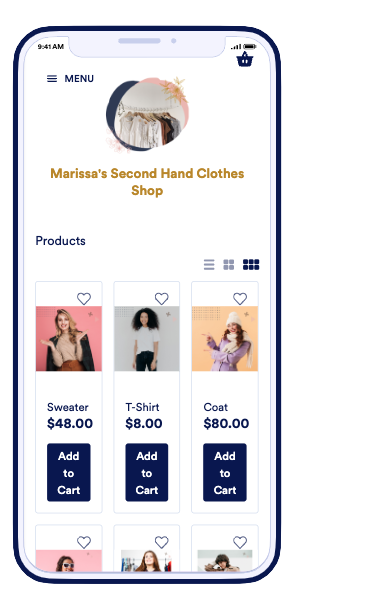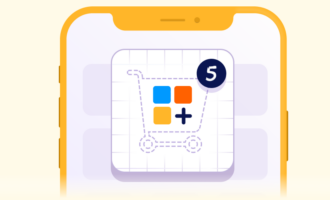Starting a dropshipping business
- Start with a plan
- Create a presence
- Get funding (but only if you need to)
- Pay attention to legal matters
- Market your marketplace
- Understand dropshipping vs fulfillment
- Pick the best business software
- Mind your own business processes
- Dive in
Earn money while you sleep. It sounds almost too good to be true, right? But it’s not.
What separates multimillionaires from everyone else? They work smart instead of just working hard. Some say the average multimillionaire has seven streams of passive income, meaning they automatically earn money without expending any effort.
Creating a dropshipping business, where you sell products online without manufacturing or warehousing them yourself, is one of the best ways to earn passive income. Once a dropshipping business is up and running, you can use that income stream to create even more passive income. But getting started still takes hard work and dedication.
If you stick it out, it can be a great income source. So let’s look at how to get started.
Start with a plan
The saying “measure twice, cut once” is all about the importance of careful planning. Whether you’ve been thinking about this type of venture for a while or the idea just popped into your head this morning, you’re going to need to plan carefully.
Brainstorming
The first thing you’ll need is a theme or niche of products to sell. Are you into gardening tools? Maybe you like oddball gadgets. Or perhaps vintage-looking modern clothing is your thing.
Whatever you want to sell, it’s important to focus on just one product category. Otherwise, you’ll find yourself competing with Amazon and Walmart.
Start by getting all your ideas out of your head. You can do it with a simple document, a mind map tool like FreeMind, or even a stack of index cards. Use whatever works best for you to get your ideas out as fast as possible before you forget them.
Creating a business plan
Now that you have all your ideas documented, it’s time to narrow down your options and choose a focus. Once that’s done, it’s time to turn those ideas into a business plan.
The nice thing about a dropshipping business is that it’s a turnkey solution with little or no overhead. So you may not need a loan to get started, which would require submitting a business plan. Even so, it’s still a good idea to create a business plan so you have a road map for your business.
A business plan will give you a point of reference to come back to as your business evolves. It’s also helpful to have when talking to advisers so they can see your vision as clearly as you do.
Writing a business plan isn’t too hard if you’ve done enough brainstorming, and there are many resources available on how to do it. The U.S. Small Business Administration (SBA) has one of the best guides on business plans. It will lead you through the whole process.
You can also get help from an SBA adviser. They’re usually retired business executives who have started and run their own businesses. They can give you personal advice from real-world experience.
Create a presence
Even if you’re selling through a third-party site like Amazon or eBay, you’ll still need to create a web presence. A business without a website or social media accounts is a huge red flag to potential customers.
Before you come up with your business name, you’ll need a domain name for your website. That’s because it’s much harder to find a good, available domain name than a business name. Here are some pointers to remember when looking for a domain name:
- Keep it short and simple. It should be easy to type, spell, and pronounce, so people can easily find you online.
- Avoid using numbers and hyphens. Do this for the same reasons as the previous tip.
- Make it relevant to your business. If you’re selling phone cases, you could try to include the word “phone” or “cases” in your domain name. For example, www.coolcases.com would be better than www.talkboxwrappers.com.
- It’s best to use a .com, but it’s not necessary. Other top-level domains (TLDs) include .org, .net, and many newer, easy-to-understand ones like .shop, .sale, .luxury, and many more. But .com is still king. Even if you get a domain like liveyour.luxury, people will still likely search for liveyour.luxury.com.
- Get creative with your domain name. Many famous sites like Shopify, Airbnb, and Instagram used creative naming to get around domain name limitations.
Social media
Once you’ve got your domain name sorted out, it’s time to start setting up your social media accounts. Even if you’re not planning on using them right away, it’s a good idea to reserve your name on all the major platforms so no one else can take it.
Picking social media names is easier than picking domain names, though. People usually don’t type them in manually, and you can usually change them later.
Get funding (but only if you need to)
As mentioned, there’s really no overhead involved with a dropshipping business. However, almost any venture has at least some business expenses. For example, you may need to pay for web hosting, marketing, and any business-related software you use.
If you can’t afford these costs in the beginning, you have options to get funding for your business. But first, you’ll need to plan more. Here’s what to keep in mind.
- Know your numbers. Before you can even approach investors or get a loan, you’ll need to have your business model completely figured out. You should do that when you make your business plan. From there, gather your costs, margins, and projected revenue.
- Be realistic about your goals. It’s OK to get a loan in order to create some wiggle room for your new business; in fact, it can help your business grow. But don’t overdo it. Keep your financial goals tied to your plan, or it may look like you’re just winging it at best — or dishonest at worst.
- Be prepared to answer tough questions. Any investor worth their salt will want to know everything about your business. They’re going to pick apart your plan and try to find any holes in it. They’re not doing this to help you out. They want to turn a profit, so they’ll do whatever they can to make sure it’s a good investment.
- Have a backup plan. Always have a plan B, C, etc. You never know when something is going to go wrong, so it’s always good to have a solid backup plan.
- Be patient. It takes time to get funding. You may have to go through a few different investors before you find one that’s a good fit for your business. And even then, it could take months to get the money you need. Be prepared to change course, but don’t give up.
Sources of financing
When it comes to finding the money to get started, you can read all the articles you want, but it’s extremely important to consult a financial adviser. Treat any information you read (including this article) as inspirational rather than informational. Talk to an accountant or other financial mentor before proceeding with these suggestions for funding methods.
- Bootstrapping: This is the best way to go for an early-stage dropshipping business. As mentioned, there’s almost no overhead, and you can probably afford to start by paying for expenses out of pocket. You can start small with only a few items until you learn the ropes. Then, once you’ve got the kinks worked out, you can use the money you’ve earned to expand.
- Crowdfunding: Platforms like Kickstarter and Indiegogo are probably not your best bet. They’re both aimed toward inventors, entrepreneurs, and creators. Dropshipping is more of a middleman business. You aren’t really creating anything new.
- Friends and family: If you have a friend who already has their seven streams of passive income, maybe they’ll help you get your first one.
Pay attention to legal matters
A dropshipping business may be easy to start, but it’s definitely not without risks. As you’re learning the ropes, you’re likely to run into dropshipping providers that don’t meet your expectations.
If you’re working with a dropshipping provider overseas, it could slow delivery times and potentially make communication a challenge. There may be issues with quality, especially if you don’t inspect your own products before adding them to your shop.
Keep your legal ducks in a row to protect yourself from the worst dropshippers. Here are a few pointers.
- Incorporation: If you’re running a dropshipping business as a sole proprietor, then you’re personally liable for all debts and obligations related to the business. This means if someone sues your business or the business can’t pay its debts, creditors can go after your personal assets, like your house or savings. Talk to your mentors to get more information on incorporation, which can safeguard you against these risks.
- Federal and state tax IDs: You’ll need to get a federal and state tax identification number for your business. This is also sometimes called an employer identification number (EIN). An EIN acts like a social security number for your business. You need one to file taxes, open a business checking account, and more.
- Licenses and permits: This is kind of a gray area. If you had a business in a brick-and-mortar location, you’d definitely need one or more permits. Some places require permits to sell online as well. Do your homework for your area to find out what you need.
- Taxes: Don’t try to hide anything from the IRS. This is one area where you definitely want to talk to a credentialed financial adviser. They can help make sure everything’s in order. Even one oversight can cost your venture big money down the road.
- Employment law: For this type of business, you can outsource a lot of the work. In fact, it’s a good idea to do that. If you’re working with firms, you probably won’t need to worry about paying taxes for them. But if you’re hiring directly or working with contractors, you’ll need to consider taxes for them as well.
It may seem unnecessary to consider all the legal stuff when you’re just getting started. But taking care of legal matters is a good practice to get into. And it will give you peace of mind as your business grows.
Market your marketplace
From your end, dropshipping is a purely digital business. You’ll rarely even see your own merchandise. You’ll never stock shelves or take your wares to a farmer’s market.
That means your business is all about driving visitors to your online store. To do that, you need to take a different approach than traditional marketing methods like TV ads.
Doing the practical, hands-on work
If you want to do your own marketing, stick with what you know at first. If you can’t pull yourself away from Twitter, use that platform to boost your business. If TikTok is more your style, product reviews and demos make for great content.
Once you’ve started to get the hang of that, expand your reach to other platforms and techniques. Udemy is a great resource for courses on marketing. It can be pricey, but it often has sales on specific courses.
Thinking like a marketer
Almost anyone can make a Facebook post or drop a cool photo in their Instagram feed. But that’s not marketing. So what is marketing?
- Understanding strategy vs tactics: Posting tweets or telling friends and family about your shop are tactics. But a strategy is a complete collection of tactics that work together to create a whole marketing solution.
- Take advantage of the long tail: The long tail is a group of low-traffic keywords that you can rank for easily. When you put together a large number of these keywords, they can bring in a lot of organic traffic. As mentioned before, you don’t want to compete with Walmart. That’s why it’s vital to pick a niche with a small audience for your business.
- Finding or creating your community and becoming a leader in it: The small niche applies to your followers as well. If you sell electronics, you’ll be competing with LG, Samsung, and Sony, to name a few. But if you sell water-gun drones, you’ll be appealing to a very small audience, and the lack of competition will create a lot of loyalty.
If you really want to think like a marketer, check out Seth Godin’s work, specifically This is Marketing. It covers a lot of what he teaches in his other books and courses in a quick and easy read.
Understand dropshipping vs fulfillment
Dropshipping is one of the fastest and best ways to launch a business and make money quickly. But it also has quite a few challenges, including the following.
- Some dropshipping businesses can be sketchy. And if they’re overseas, it can be hard to hold them accountable. You’d need a lawyer who practices international business law.
- It can be hard to find reliable dropshipping partners. That can mean trial and error. And unfortunately, it’s your customers who will pay the price.
- It can be difficult to automate a dropshipping business, especially if you’re working with multiple dropshippers. There’s software to help with that problem, but it’s still a challenge.
- You may be restricted on how you can sell and who you can sell through. For example, Amazon has some pretty strict dropshipping policies.
All of these challenges have solutions, but it can be an uphill battle. There’s another way, though: fulfillment solutions.
Fulfillment partnerships
Fulfillment solutions are another turnkey business solution that works a lot like dropshipping.
The idea behind fulfillment businesses is that instead of having your inventory shipped to customers one at a time from dropshippers, you have it shipped in bulk to a fulfillment partner. They store your merchandise in their warehouses. And when someone places an order, the fulfillment partner packs it, ships it, and handles returns and customer service.
That’s the same as what you can expect from a dropshipper, but with a fulfillment partner, you get a few more benefits.
- You’ll have a lot more control over your business. Every dropshipper may have its own policies and practices. You’ll have to change how you operate to keep up with them and their changes.
- You’ll have fewer partners to deal with. You probably won’t be able to sell from just one dropshipper — not if you want to maintain a good-sized selection, that is. But if you use fulfillment services, you can do most of your business with just one fulfillment company.
- You can sell products from literally any wholesaler. This can improve the quality of products and will give you many more options.
- Shipping times will be shorter and more consistent.
- Automation will be a snap. Many fulfillment partners provide automation tools.
Fulfillment does have a couple of drawbacks as well, though:
- It requires an investment. This is the reason people recommend making money with dropshipping first and ramping up slowly.
- You’ll have to hold an inventory. If something doesn’t sell, you may have made a bad investment. And you’ll still have to pay to house all that unwanted merchandise.
The transition to fulfillment
If you decide that fulfillment is the best move, there are a few tips.
- Start slowly. It can be tempting to send a bunch of merchandise to your new fulfillment partner. But it’s best to start with a small quantity of one or a few popular products.
- Phase out duds. If you have products that never sold very well, leave them behind.
- Phase in gems. Replace those duds with better-quality merchandise that might sell better. But once again, start with small quantities in case better quality doesn’t help sales.
- Find a good fulfillment partner. Amazon Supply Chain is an excellent choice. But you may want to research other options. You may be able to form a better relationship with a smaller business. They’ll likely work harder to keep your business as well.
Pick the best business software
In addition to finding the best dropshipping software, you’ll need good software for the rest of your business as well. These are some of the best solutions on the market.
- Google’s cloud-based suite of tools — such as Google Docs, Gmail, and Meet — will let you and your team communicate and work together in real time. And when your business grows, Google offers Workspace, which is designed for companies of every size — from tiny mom-and-pop businesses to massive enterprises.
- Jotform is an online form builder and automation tool that can help with everything from collecting and tracking orders to processing payments and automating workflows. Its versatility means that you can use it in all kinds of business processes.
- ClickUp is one of the most flexible productivity tools currently available. Whether you need a few checklists or a huge collection of custom automations designed to manage every aspect of your business, ClickUp can help. The one drawback is that it’s kind of a lot to learn if you’re not a very tech-savvy person, but it’s worth your time to pick it up.
Now that we’ve met some of the software, let’s learn how you can use it in all of your business processes.
Mind your own business processes
Even if your dropshipping business is just you sitting in a coffee house with your laptop at first, it’s never too early to start thinking about how to run a larger organization.
Once you start building up your business, you’re going to find yourself wearing several hats. That’s a good thing. It will give you a chance to learn all the many roles it takes to manage a business. Then, you can streamline each one and create systems for them. That will make training new hires easier.
For tips on refining and streamlining your processes, check out The E-Myth Revisited by Michael Gerber, an excellent book that will teach you how to work on your business, not just in your business. Another good resource is The 4-Hour Workweek by Tim Ferris, which shows you how to automate and outsource much of your business.
Here are some common business processes along with tools and tricks for managing them.
- Accounting: This involves bookkeeping, payroll, and taxes. QuickBooks is a popular choice for small businesses and the self-employed.
- Human resources: This department handles hiring, firing, employee engagement, managing benefits, and more. You can tackle many of your HR needs with Jotform. You can use it to collect résumés, fill out legal documents, manage employee lists and information, collect legally binding signatures, and much more.
- Customer service: Keeping your customers happy is probably the most important part of your business. This is another area where Jotform is your friend. You can create forms to collect requests, product feedback, and more.
- Research and development: You’ll need to be constantly searching for new inventory to keep your customers excited about your brand. You can track all of your research using Google Docs. It’s also great for collaborating on documents.
- Marketing: In addition to the resources we talked about above, Jotform has many marketing form templates you can use to collect email addresses, conduct market research, and much more. Buffer can help streamline your social media marketing by automating posts. And Mailchimp will help you launch professional email campaigns that don’t get flagged as spam.
- Quality assurance: It’s vital to make sure the products you deliver meet the highest standards possible. Jotform can help you streamline the quality assurance process as well. With Jotform Approvals, you can automate approval workflows so that you can easily track and sign off on critical steps in business processes.
- Manufacturing: You’ll need a lot of records and documents to manage your manufacturing processes. Google Docs and Jotform can help you store and organize them.
- Web presence and online storefront: This part can be overwhelming for people with a non-technical background. Fortunately, there are many tools that make the process easy for anyone to tackle. Jotform Store Builder can help you get a shop up and running in minutes with more than 100 store templates to choose from. You can use it to list products, accept payments, track orders, and more.
Dive in
There’s a lot involved in starting a business. But the most important thing is to start! Don’t overthink it. Don’t psych yourself out. Just roll up your sleeves and get to work.
Whatever success looks like for you, here’s hoping you’ll see it. And here’s to you for taking the first steps!
































Send Comment: